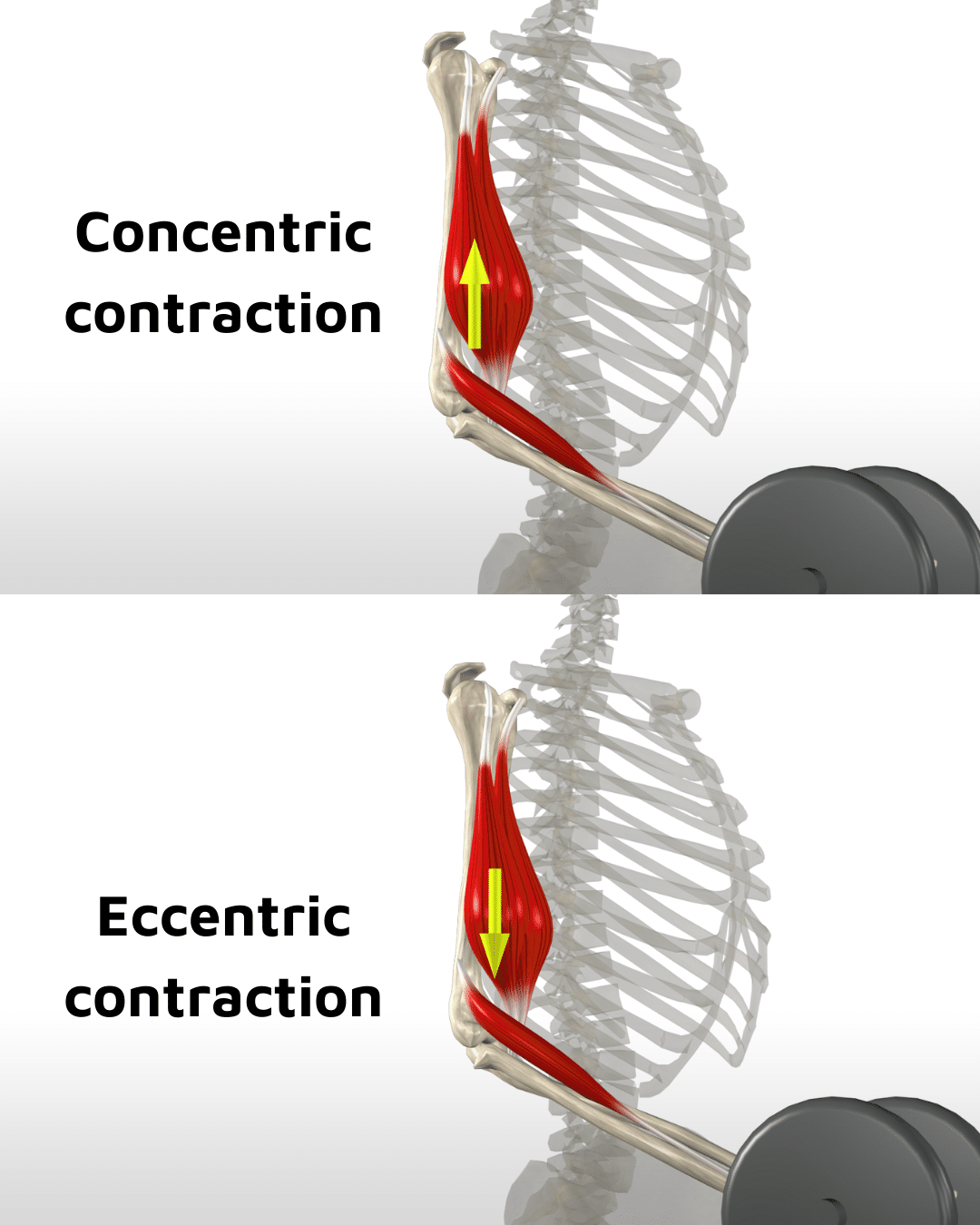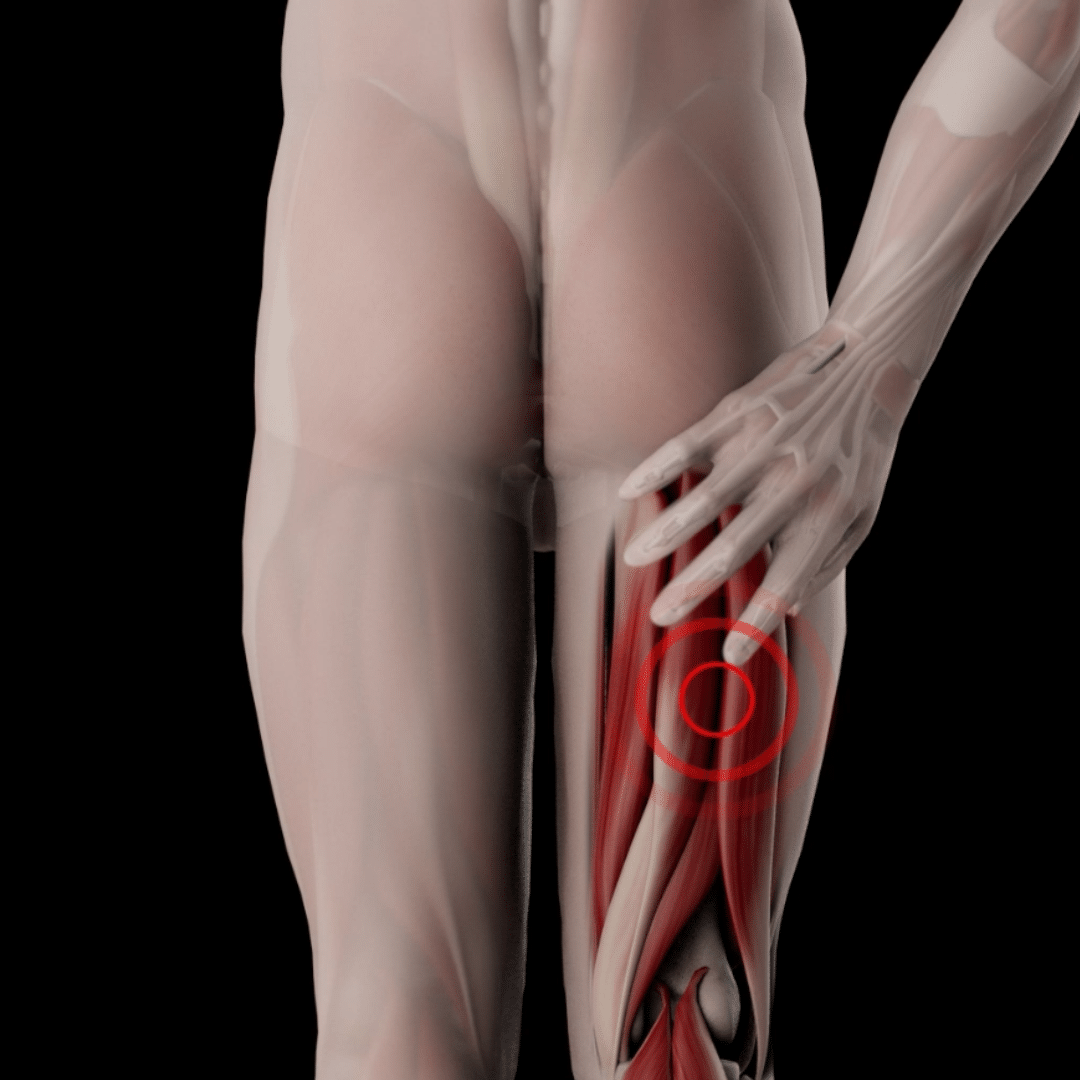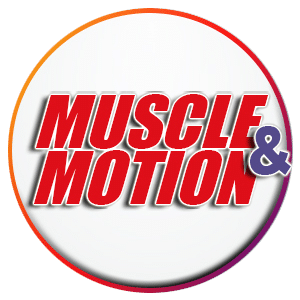Eccentric contractions are a type of muscle contraction in which the muscle-tendon complex lengthens and contracts at the same time. This type of contraction has several distinct traits distinguishing it from other contractions, potentially resulting in unique adaptations. Due to its particular physiological and mechanical characteristics, eccentric muscle work has garnered growing attention for rehabilitation and clinical objectives.
This Muscle and Motion article will delve into eccentric muscle contractions and explore who can benefit from them and why. Additionally, we’ll examine recent literature findings on this topic and provide sample exercises for you to incorporate.
What is eccentric contraction?
An eccentric muscle contraction occurs when an external force applied to the muscle is greater than the force the muscle generates at that moment. The external force causes the muscle and tendon to lengthen while still contracting.[1] During this process, the muscle absorbs energy from the external load, which is why this type of contraction is often referred to as “negative work.” Contrary to common belief, eccentric muscle contractions are vital components of both everyday activities and sports movements.
These contractions occur in almost any exercise and when the muscles stretch to support the body against gravity, absorb shocks, or store elastic energy for upcoming concentric contractions.
To learn more about the other types of muscle contractions, check out our video and the following article.
What are the benefits of eccentric exercise?
A systematic review by Douglas et al. in 2017 investigated the long-term effects of eccentric training, which include:
- Muscle strength: Eccentric training has been shown to significantly improve muscle strength. This means that when muscles lengthen while under tension, they become stronger, which can enhance overall physical performance.[2]
- Enhanced power and stretch-shortening cycle function: Eccentric training can lead to superior gains in power and the stretch-shortening cycle function. This is particularly beneficial for activities that require quick and explosive movements, such as jumping and sprinting.[2]
- Hypertrophy: Eccentric training is at least as effective as other training methods in increasing muscle cross-sectional area (size). However, the pattern of muscle growth may be nuanced, with potential longitudinal growth (adding sarcomeres in series) within muscles.[2]
- Type II muscle fiber growth: Eccentric training often results in a preferential increase in the size of type II muscle fibers. These fibers are responsible for generating high force and power, making them crucial for activities like weightlifting and sprinting.[2]
- Tendon tissue changes: Qualitative and quantitative changes in tendon tissue have been observed with eccentric training. These changes may be related to the magnitude of strain imposed during the exercises, potentially contributing to improved tendon health and resilience.[2]

Eccentric training and injury prevention
In the realm of injury prevention and rehabilitation, eccentric training has emerged as a powerful and indispensable tool physical therapists’ and rehabilitation professionals’ arsenals. Its efficacy in aiding recovery from various musculoskeletal conditions has made it a preferred choice for promoting healing and injury prevention.
-
Reducing lower extremity injuries
One compelling aspect of eccentric training is its ability to reduce the risk of lower extremity injuries significantly. A comprehensive analysis revealed that implementing a hamstring eccentric training program resulted in a remarkable 28% decrease in lower extremity injuries. This training approach also led to a 46% reduction in hamstring injuries and a 34% decrease in knee injuries. These findings underscore the valuable role eccentric exercises can play in safeguarding athletes and individuals from common lower limb injuries.[3]

-
Enhancing neuromuscular control
Eccentric training also offers advantages in terms of neuromuscular control, particularly following injury. It facilitates connection between the brain and the injured muscle, aiding in the restoration of optimal function. This is particularly significant since injury-related research has demonstrated alterations in brain function. By improving neuromuscular control, eccentric exercises contribute to a more comprehensive and effective recovery process.[4]
Examples of eccentric exercises
To illustrate the practical application of eccentric training, let’s examine a few examples and identify who can benefit from these exercises.
The Nordic hamstring curl is a highly effective eccentric exercise known for its ability to strengthen the hamstrings while reducing the risk of injury. Hamstring injuries often occur during activities like running and sprinting. These muscles are vulnerable due to their anatomical structure, spanning two joints (the knee and hip) with opposing actions on the hamstring length.
The hamstrings play a critical role in decelerating the body during high-speed movements, increasing their susceptibility to injury, especially when transitioning from knee extension to hip extension.
The Copenhagen hip adduction exercise is a highly effective eccentric movement renowned for improving adductor muscle strength while minimizing the likelihood of injuries. Injuries involving the adductors often occur during activities that demand lateral stability and quick changes in direction. The adductor muscles on the inner thigh are at particular risk due to their role in stabilizing the hip joint. This exercise becomes especially valuable for individuals involved in sports or activities requiring rapid shifts in direction and lateral movements.
The eccentric push-up, often referred to as the negative push-up, is a valuable exercise for individuals who are mastering the traditional push-up. This variation of the P\push-up emphasizes the controlled lowering phase, which helps build strength since the body can generate more force during the downward phase (eccentric contraction) than the upward phase (concentric contraction).
The single-arm eccentric pull-up is an essential stepping stone for individuals aspiring to perform the challenging one-arm pull-up, a remarkable display of upper body strength and control. This exercise focuses on building the strength and stability in your upper body and core to execute a full one-arm pull-up eventually.
The eccentric biceps curl is a unique approach to target the biceps muscles while providing added resistance. This exercise is great for promoting muscle growth and strength in the biceps. Still, it can also benefit individuals with biceps tendinopathy and can serve as a preventive measure against biceps tears.
Integrating these exercises into your training program can offer many advantages, such as enhanced strength and injury prevention. However, executing them accurately and seeking professional guidance is vital, especially if you’re new to eccentric training or require specialized rehabilitation.
For comprehensive instructions and step-by-step guidance on each exercise, we recommend checking out our strength training app.
At Muscle and Motion, we believe that knowledge is power, and understanding the ‘why’ behind any exercise is essential for your long-term success.
Let the Strength Training App help you achieve your goals! Sign up for free.
Reference
- Lindstedt, S. L., LaStayo, P. C., & Reich, T. E. (2001). When active muscles lengthen: Properties and consequences of eccentric contractions. Physiology (Bethesda, Md.), 16(6), 256–261
- Douglas, J., Pearson, S., Ross, A., & McGuigan, M. (2017). Chronic adaptations to eccentric training: A systematic review. Sports Medicine (Auckland, N.Z.), 47(5), 917–941.
- Hu, C., Du, Z., Tao, M., & Song, Y. (2023). Effects of different hamstring eccentric exercise programs on preventing lower extremity injuries: A systematic review and meta-analysis. International Journal of Environmental Research and Public Health, 20(3), 2057.
- Lepley, L. K., Lepley, A. S., Onate, J. A., & Grooms, D. R. (2017). Eccentric exercise to enhance neuromuscular control. Sports Health, 9(4), 333–340.
- Schoenfeld, B. J., Ogborn, D. I., Vigotsky, A. D., Franchi, M. V., & Krieger, J. W. (2017). Hypertrophic effects of concentric vs. Eccentric muscle actions: A systematic review and meta-analysis. Journal of Strength and Conditioning Research, 31(9), 2599–2608.


